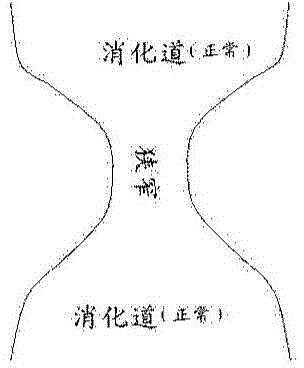Customized alimentary canal support and moulding method and application method thereof
A molding method and digestive tract technology, applied in the field of medical devices, can solve the problems of obvious improvement in stent failure rate, inability to fit the digestive tract stent, inability to reduce the internal stress of the stent, etc., to achieve reduced possibility, excellent fit, and reduced sliding the possible effect of
- Summary
- Abstract
- Description
- Claims
- Application Information
AI Technical Summary
Problems solved by technology
Method used
Image
Examples
Embodiment 1
[0062] A) Establish a three-dimensional model of the digestive tract structure of the individual subject including the stenosis or obstruction of the digestive tract Obtain structural data of the digestive tract through CT
[0063] Patients generally eat a certain amount of contrast medium according to the guidance of clinicians before undergoing CT. It is also possible not to eat contrast agent, only for image enhancement. Use SOMATOMEmotion6-slice configuration (Shanghai Siemens Medical Instrument Co., Ltd.) to obtain the digestive tract structure data of the subject according to the manufacturer's instructions, and save the obtained data in DICOM format. Various MRIs and CTs that can effectively obtain the structure of the digestive tract can be used in the present invention. image 3 A coronal CT reconstruction image of a patient is shown showing a narrowed bowel lumen with heterogeneous thickening of the bowel wall as indicated by white arrows.
[0064] Generation of 3D...
Embodiment 2
[0081] Such as Figure 7 Another example of a patient-based personalized digestive tract scaffold fabricated using the methods described herein is shown. It has a network structure formed by nitinol wires in the way of positive and negative helical crossing, and its central axis has a bend of about 90 degrees. The diameter of the stent varies with the diameter of the digestive tract to be implanted. The range is between 5mm and 40mm. Laser welding is performed at the intersection points to achieve a grid-like stent structure.
Embodiment 3
[0083] Figure 8 Another example of the present invention is shown, which is used at the gastrointestinal transition, which has two transitions, complex structure, and large diameter variation, where the failure rate of conventional stents is high, and the forming method of the present invention is adopted The obtained personalized digestive tract stent fits well with this structure, and can basically maintain a stable position during the peristalsis of the stomach.
PUM
| Property | Measurement | Unit |
|---|---|---|
| Diameter | aaaaa | aaaaa |
Abstract
Description
Claims
Application Information
 Login to View More
Login to View More - Generate Ideas
- Intellectual Property
- Life Sciences
- Materials
- Tech Scout
- Unparalleled Data Quality
- Higher Quality Content
- 60% Fewer Hallucinations
Browse by: Latest US Patents, China's latest patents, Technical Efficacy Thesaurus, Application Domain, Technology Topic, Popular Technical Reports.
© 2025 PatSnap. All rights reserved.Legal|Privacy policy|Modern Slavery Act Transparency Statement|Sitemap|About US| Contact US: help@patsnap.com



